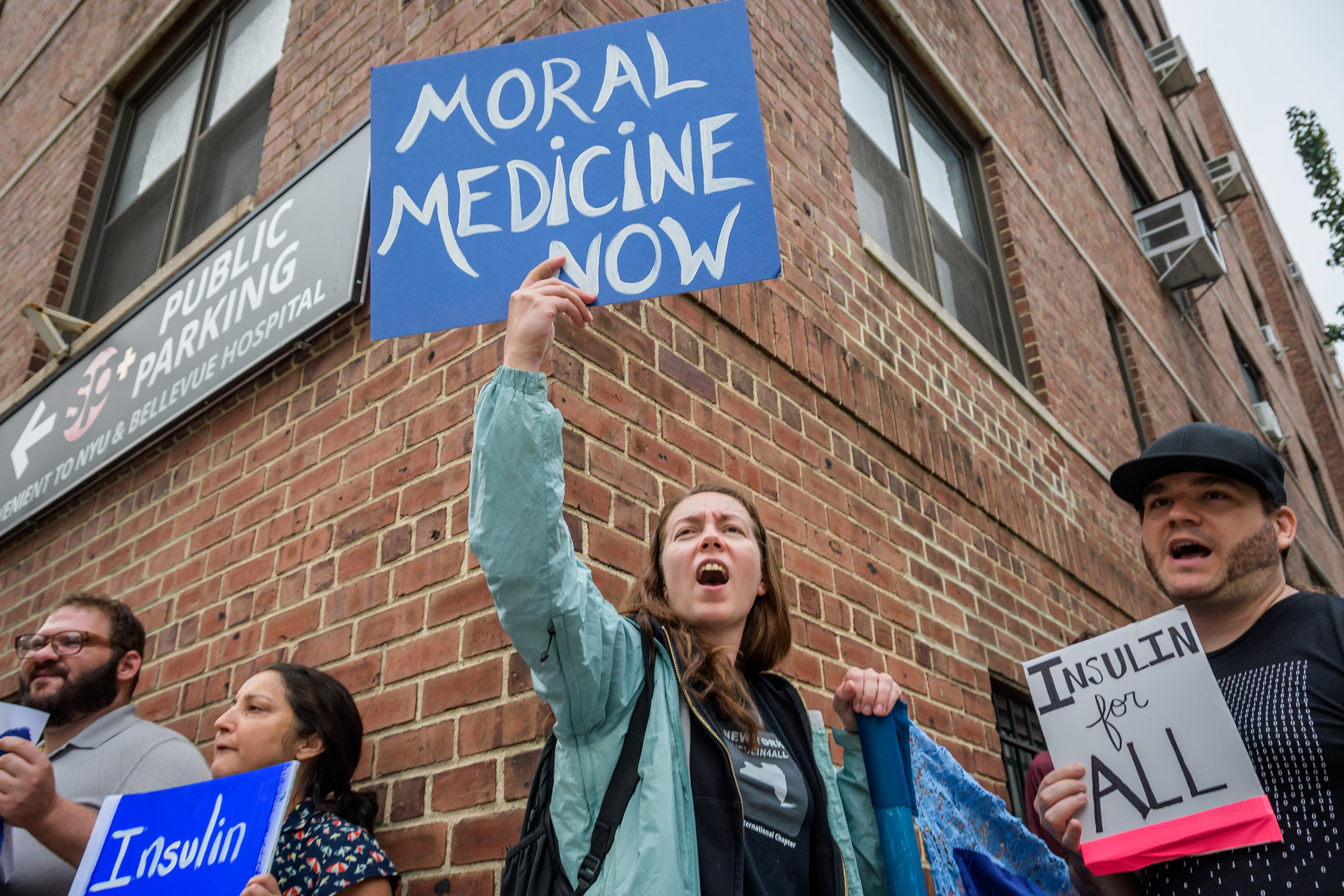
Kunal Kumar – April 1, 2022
Editor: Katherine McKernan
Introduction
Legislation, activism, and policy reform. None of these forces have been strong enough to slow down the inevitable manipulation and eventual overturn of the United States healthcare system. As socioeconomic inequality rises and corporate power increases its control over institutions, healthcare has succumbed to rapid privatization and profit-inducing measures, much of which has come at the hands of Big Pharma. Though attempts have been made to subvert the adverse effects of the healthcare system, difficulties in affording healthcare, among other issues, still rampage across the country.
Market manipulation in the healthcare industry takes many forms, many of which are rooted in inflating prices to stimulate profits. Pharmaceutical corporations promote their own products by allocating a large portion of their funds to marketing. Moreover, private equity ownership of nursing homes and ambulance services has led to decreasing extraneous costs in an attempt to maximize profits. Consolidation of power amongst hospitals has limited competition and allowed hospitals to leverage their market power to raise prices.
Big Pharma
Over the past few decades, pharmaceutical companies have shifted their intentions to increasing profits over the long-run. In doing so, they have implemented several marketing strategies to establish a large stake in the healthcare industry. For example, direct-to-consumer (DTC) now accounts for nearly a third of total medical marketing, a figure that increased by over twenty percentage points from 1997 to 2016. Not only are pharmaceutical companies increasing marketing to consumers, but they also have directly targeted healthcare services and professionals. In fact, pharmaceutical marketing to healthcare professionals remains the highest area of promotional spending.
It is not difficult to see how increased spending on medical marketing is harmful for American healthcare and the typical consumer. Big Pharma receives federal assistance in several ways, including funding for research and tax deductions for marketing and advertising, which allows it to utilize federal funds and taxpayer dollars for development and distribution of new drugs. While developing prescription drugs is a form of technological advancement that could potentially have positive effects on treating health issues, the over-distribution of these drugs can be dangerous. Patients can become increasingly reliant on these prescriptions following their procedures and eventually suffer from addiction. In 2019, prescription opioids played a role in 28% of all opioid overdose deaths, according to data from the CDC. Pharmaceutical companies and doctors work in conjunction to develop these products and, in turn, raise demand – and prices. With more prescriptions in the market, consumers are purchasing pharmaceuticals at an all-time high rate. However, the necessity of prescription drugs like metformin for insulin and adalimumab for Humira (rheumatoid arthritis), coupled with reduced competition from patenting, allows pharmaceutical companies to exponentially increase prices. Consumers are left with no choice but to pay higher prices, leading to Americans spending a total of $535 billion on prescription drugs, a number that has increased by 50% since 2010. Insulin prices, for example, are more than eight times higher in the US than in the prices of the 30 most high-income countries combined. As long as political lobbying and government funding aid pharmaceutical companies, American consumers can expect to pay increasingly unaffordable prices for prescription drugs.
Private Equity Ownership
Over the last decade, increasing investment by private equity firms has corrupted healthcare, as annual estimated deal values reached nearly $120 billion in 2019. Driving these investments are COVID-related market disruptions, large amounts of univensted capital held by private equity firms, and overall increases in healthcare expenditure. Private equity firms are rooted in flipping businesses for short-term revenue, which is done by forcing these businesses to incur debt, reducing costs, and letting go of significant assets. This is particularly harmful for the healthcare industry, as the prospect of short-term revenue comes at the cost of ignoring quality of care and promoting unethical billing practices. Blackstone, Apollo Global Management, and The Carlyle Group are the biggest private equity firms that have taken control of healthcare services like nursing homes and air ambulance companies. As COVID causes many rural hospitals to shut down, air ambulances are becoming increasingly common – and expensive. Since patients pay bills after their procedures are completed, healthcare services – now pressured by private equity firms – can charge higher prices with no consequences. A key result of this issue is that healthcare markets have become more concentrated and less competitive, which leads to higher profits at the expense of proper, efficient healthcare.
The Effects of Decreased Competition
As rural hospitals have experienced widespread closures over the past few decades and lost staff, patients, and funding during the pandemic, local monopolies have begun to dominate rural areas, which has led to high prices. While competition continues to decline, hospitals will continue to take advantage of their market power, as reflected by their increased prices compared to hospitals in competitive locations. Hospitals that operate as local monopolies have prices that are 12% higher than those of hospitals with competition.
Furthermore, insurance companies and policies play an important role in developing the relationship between hospital rates and consumer behavior. A wave of advertising among hospitals in New York has led everyday workers across all industries to inquire about including these hospitals in their insurance plans. With mounting pressure to put these newly advertised hospitals in their insurance plans, insurance companies lose all prospects of negotiating power with hospitals. In turn, hospitals enjoy more profits that are not used to expand technology or medicinal practices, but rather to pay top executives a higher salary. New York Presbyterian notoriously started a well-run ad campaign that allowed for the hospital to successfully raise prices – and for its CEO, Dr. Steven Corwin, to enjoy a higher salary. Since these executives are the ones advocating for advertising campaigns and negotiating with insurance companies, they are handsomely compensated – while patients continue to be charged unreasonable prices that they have no choice but to pay.
Breakdown of Costs for the Average Individual
As of 2020, the average cost of health insurance in the United States is $7,470 per year, a figure that is only expected to increase. Healthcare has absorbed a great deal of national income – up to 18% in 2017 – leaving employees with significantly less income to spend elsewhere. Although employer-sponsored health insurance often covers a large portion of an individual’s spending on healthcare, these plans have arguably made financial situations worse for Americans. For example, increases in insurance premiums are factored into wage costs, so employees actually receive lower wages than anticipated. This has played a role in real wage stagnation across the United States over the last 50 years.
Low income workers are disproportionately impacted by rising healthcare costs and are subject to unemployment and even lower wages. For workers who earn half of the median wage, the average insurance plan for families accounts for 60% of the wage cost, decincentiving employers to either provide employer sponsored health insurance or to hire these workers altogether. It is also important to consider the 51% of the population whose care is not covered by employer-sponsored health insurance. Private health insurance prevents premiums from being paid on a pre-tax basis.
In certain regions, this figure is much larger, as geographical location and cost of living affect private health insurance rates. For example, residents of the East Coast, Northern California, and the upper Midwest are susceptible to higher costs. Regardless of whether a worker chooses employer-sponsored or private health insurance is their choice, but both plans have their downfalls. Employer-sponsored plans force workers to pay in hidden premium costs and private insurance plans force workers to simply pay more for premiums. The 10% of the population without insurance bear even more consequences than those with coverage. Since bills typically arrive once treatment is already given, those without insurance plans can often spiral into debt and never recover financially from treatment costs.
Breakdown of Spending Costs
With spending on healthcare reaching record amounts, one cannot help but wonder where all this spending is allocated. Recent data shows that a third of spending goes to hospital care. In the United States, doctors are paid roughly twice as much as the average doctor in the top 38 countries based on incomes, according to the Organisation for Economic Cooperation. Moreover, high selectivity for medical schools and discrimination against doctors with foreign credentials allow for doctors in the United States to have more bargaining power in determining their wages. Around ¼ of healthcare spending goes to professional services, which is the work done in locations that are not hospitals. In addition, getting procedures done typically amounts to high costs for patients, and is even more expensive in the United States. For example, hip replacements are nearly 4 times more expensive in the United States than they are in several European countries. Meanwhile, MRIs are $1,100 in the US and $300 in Britain. This perpetuates a cycle that widens the gap between patients and healthcare professionals, creating an inefficient healthcare system that prioritizes profits over patient care.
Conclusion
Healthcare in the United States is certainly one of the most advanced systems in the world. However, there are significant economic concerns that have caused healthcare to negatively impact many individuals. Increasing costs for prescriptions empties countless wallets, but leads to better profits for big pharmaceutical companies and hospitals. As hospitals charge higher prices due to decreased competition and private equity prioritizes profits over quality of care, patients can face serious financial struggles. Until the healthcare system begins to put more attention on patient’s economic concerns, these concerns will only cause more suffering.
Featured Image Source: Time Magazine
Disclaimer: The views published in this journal are those of the individual authors or speakers and do not necessarily reflect the position or policy of Berkeley Economic Review staff, the Undergraduate Economics Association, the UC Berkeley Economics Department and faculty, or the University of California, Berkeley in general.



